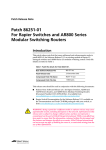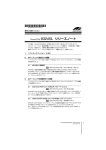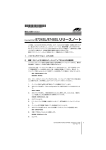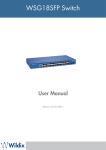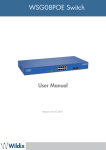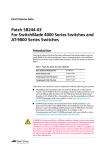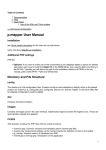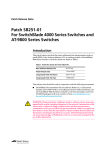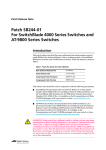Download Allied Telesis Rapier Series User's Manual
Transcript
Patch Release Note
Patch 86253-03
For Rapier Series Switches
Introduction
This patch release note lists the issues addressed and enhancements made in
patch 86253-03 for Software Release 2.5.3 on existing models of Rapier series
switches. Patch file details are listed in Table 1.
Table 1: Patch file details for Patch 86253-03.
Base Software Release File
86s-253.rez
Patch Release Date
30-July-2003
Compressed Patch File Name
86253-03.paz
Compressed Patch File Size
191102 bytes
This release note should be read in conjunction with the following documents:
■
Release Note: Software Release 2.5.3 for Rapier Switches and AR400 and
AR700 Series Routers (Document Number C613-10362-00 Rev A) available
from www.alliedtelesyn.co.nz/documentation/documentation.html.
■
Rapier Switch Documentation Set for Software Release 2.5.1 available on
the Documentation and Tools CD-ROM packaged with your switch, or
from www.alliedtelesyn.co.nz/documentation/documentation.html.
WARNING: Using a patch for a different model or software release may cause
unpredictable results, including disruption to the network. Information in this
release note is subject to change without notice and does not represent a
commitment on the part of Allied Telesyn International. While every effort has
been made to ensure that the information contained within this document and
the features and changes described are accurate, Allied Telesyn International
can not accept any type of liability for errors in, or omissions arising from the
use of this information.
Sim ply connectin g th e wo rld
2
Patch Release Note
Some of the issues addressed in this Release Note include a level number. This
number reflects the importance of the issue that has been resolved. The levels
are:
Level 1
This issue will cause significant interruption to network services, and
there is no work-around.
Level 2
This issue will cause interruption to network service, however there
is a work-around.
Level 3
This issue will seldom appear, and will cause minor inconvenience.
Level 4
This issue represents a cosmetic change and does not affect network
operation.
Features in 86253-03
Patch 86253-03 includes all issues resolved and enhancements released in
previous patches for Software Release 2.5.3, and the following enhancements:
PCR: 03816
Module: IPG
Level: 2
When ports were added or removed as a range with the ENABLE IP IGMP
ALLGROUPS and DISABLE IP IGMP ALLGROUPS commands, port
values were interpreted as 2 separate ports. This issue has been resolved.
Features in 86253-02
Patch file details are listed in Table 2:
Table 2: Patch file details for Patch 86253-02.
Base Software Release File
86s-253.rez
Patch Release Date
25-July-2003
Compressed Patch File Name
86253-02.paz
Compressed Patch File Size
190900 bytes
Patch 86253-02 includes the following enhancements and resolved issues:
PCR: 03420
Module: IPG, SWI
Level: 3
It is now possible to prevent specified ports from acting as IGMP all-group
ports, and specify which ports are allowed to behave as all-group entry
ports. This is enabled with the ENABLE IP IGMP ALLGROUP command,
and disabled with the DISABLE IP IGMP ALLGROUP command.
For details, see “IGMP Snooping All-Group Entry” on page 5.
PCR: 03515
Module: DHCP
Level: 3
DHCP was offering network and broadcast addresses to clients. This issue
has been resolved.
Patch 86253-03 for Software Release 2.5.3
C613-10382-00 REV B
Patch 86253-03 For Rapier Series Switches
PCR: 03609
3
Module: OSPF
Level: 1
The IP route filter did not always work correctly for OSPF. This issue has
been resolved.
PCR: 03657
Module: SWI
Level: 3
Executing the DISABLE SWITCH PORT command on a port that was the
source of a mirror port did not disable the mirror port. This issue has been
resolved.
PCR: 03691
Module: DVMRP
Level: 2
A fatal error occurred if the number of DVMRP interfaces being added
exceeded the limit. This issue has been resolved.
PCR: 03692
Module: BGP
Level: 2
Occasionally a fatal exception may have occurred when sending BGP
aggregate routes. This issue has been resolved.
PCR: 03696
Module: IPG
Level: 2
IGMP snooping entries were not being deleted from the hardware table.
This issue has been resolved. Also, port timers are now updated when the
IGMP timeout is changed.
PCR: 03698
Module: DVMRP
Level: 3
The output of the SHOW DVMRP FORWARDING command did not
display the forwarding ports. This issue has been resolved.
PCR: 03707
Module: STP
Level: 2
When adding a port to a VLAN, any STP ports that had been disabled in the
default STP were re-enabled. This issue has been resolved.
PCR: 03708
Module: DHCP
Level: 2
When the DELETE DHCP RANGE command was executed, DHCP
attempted to reclaim the addresses in that range. It also tried to reclaim
addresses in that range that were not allocated at that time, resulting in
duplicate addresses appearing on the free list for allocation. This has been
resolved by allowing DHCP to reclaim only those addresses that are
currently in use by one of its clients.
PCR: 03720
Module: STP
Level: 2
When changing from RSTP to STP mode, the STPCOMPATIBLE option for
the RSTPTYPE parameter incorrectly appeared in the dynamic
configuration. Also, when changing from RSTP to STP mode or vice versa,
disabled STP ports did not remain in the disabled state. These issues have
been resolved.
PCR: 03738
Module: IPG
Level: 2
If a port went down, the port was deleted from the appropriate static IGMP
associations but was not added back again when it came back up. Similarly,
static IGMP associations were automatically deleted but not added back
when IP or IGMP was disabled. These issues have been resolved. You can
now create IGMP associations before enabling IGMP, and they will become
active when IGMP is enabled.
Patch 86253-03 for Software Release 2.5.3
C613-10382-00 REV B
4
Patch Release Note
PCR: 03741
Module: FIREWALL
Level: 3
The maximum number of firewall sessions had decreased since software
release 86s-241. This issue has been resolved.
PCR: 03742
Module: IPV6
Level: 2
Previously, an incorrect source address was used for router advertisements
that were sent over an IPv6 tunnel. The source address of the tunnel
(specified by the IPADDRESS parameter of the ADD IPV6 TUNNEL
command) was used instead of a link local address. This caused an
interoperability problem, which has been resolved. Now, if the specified IP
address is not a link local address, then a link local address will be created
based on the IPv4 tunnel source address and used for router
advertisements.
PCR: 03743
Module: IP
Level: 3
If a ping was active and the IP configuration was reset, subsequent pings
were sent out the wrong interface. This issue has been resolved.
PCR: 03744
Module: PING
Level: 3
Executing a ping to the IP address 0.0.0.0 did not return an invalid
destination address error message. Also, when the TRACE command
was executed for local addresses, it timed out after 90 seconds. These issues
have been resolved.
PCR: 03764
Module: IPG
Level: 3
The IP multicast counter did not increment when IGMP, DVMRP and PIM
packets were transmitted and received. This issue has been resolved.
PCR: 03766
Module: FIREWALL
Level: 2
The firewall denied streaming data using Windows Media Player 9. This
issue has been resolved.
PCR: 03779
Module: DHCP
Level: 2
The DHCP client was not honouring a subnet option provided by the DHCP
server. This issue has been resolved.
PCR: 03783
Module: IPG
Level: 3
The TIMEOUT and SIZE parameters are only valid for the SET IP DNS
CACHE command, but no error message was returned if either parameter
was specified for the SET IP DNS command. This issue has been resolved.
PCR: 03784
Module: IPV6
Level: 3
Fragmentation of IPv6 packets now complies with RFC 2460’s requirement
to align packet sizes to 8 octets.
PCR: 03788
Module: DHCP
Level: 2
The DHCP server did not send a DHCPNAK message when a previously
statically assigned IP DHCP entry was again requested by a client. This
issue has been resolved.
Patch 86253-03 for Software Release 2.5.3
C613-10382-00 REV B
Patch 86253-03 For Rapier Series Switches
PCR: 03793
5
Module: RSVP
Level: 3
The ENABLE RSVP INTERFACE command did not succeed if IP was
enabled after the RSVP interface had been created. Now, ENABLE RSVP
INTERFACE will succeed regardless of when IP is enabled as long as an IP
interface exists.
PCR: 03799
Module: DHCP
Level: 3
When a new static entry was allocated to a client, an old dynamic entry
remained inuse for a full lease period. This issue has been resolved. The old
entry will now be reclaimed when the client attempts to renew its lease and
receives the new static entry.
IGMP Snooping All-Group Entry
Because IGMP is an IP-based protocol, multicast group membership for VLAN
aware devices is on a per-VLAN basis. If at least one port in the VLAN is a
member of a multicast group, multicast packets will be flooded onto all ports in
the VLAN by default.
IGMP snooping enables the switch to forward multicast traffic intelligently on
the switch. The switch listens to IGMP membership reports, queries and leaves
messages to identify the switch ports that are members of multicast groups.
Multicast traffic will only be forwarded to ports identified as members of the
specific multicast group.
This enhancement allows network managers to prevent specified ports from
acting as IGMP all-group ports, and specify which ports are allowed to behave
as all-group entry ports, by using the ENABLE IP IGMP ALLGROUP
command.
For example, consider a video streaming service which has 15 channels. When
the switch receives IGMP membership reports destined for the address
239.0.0.2 from an unauthorised user, all 15 channels of multicast data floods to
that port, which may affect the service of the network. In order to avoid this,
the network manager decides whether or not to allow a particular port to
behave as an IGMP all-group port, e.g. port 8. Then, whenever the above IGMP
membership report is sent, the switch will not automatically add port 8 as one
of the egress ports for any IGMP membership report group, so video streaming
will not get forwarded to disabled all-group ports selected by the network
manager.
Commands
This enhancement modifies one command:
■
SHOW IP IGMP
and has two new commands:
Patch 86253-03 for Software Release 2.5.3
C613-10382-00 REV B
■
ENABLE IP IGMP ALLGROUP
■
DISABLE IP IGMP ALLGROUP
6
SHOW IP IGMP
Patch Release Note
Modified Command
SHOW IP IGMP
Syntax
Description
SHOW IP IGMP [COUNTER] [INTERFACE=interface]
This command displays information about IGMP, and multicast group
membership for each IP interface.
This enhancement includes the line “Disabled All-groups ports” on the output
of this command, as show in Figure 1 on page 6. Ports that are disabled have a
“#” symbol next to the port number.
Figure 1: Example output from the SHOW IP IGMP command.
IGMP Protocol
-------------------------------------------------------------------------------Status ........................... Enabled
Default Query Interval ........... 125 secs
Default Timeout Interval ......... 270 secs
Disabled All-groups ports ........ 1,5,7
Interface Name .......... vlan2 (DR)
IGMP Proxy .............. Off
Group List ..............
Group. 238.0.1.2
Ports 3,11,23
Last Adv. 172.50.2.1
Refresh time 34 secs
Group. 224.1.1.2
Ports 2,11,23
Last Adv. 172.50.2.1
Refresh time 130 secs
All Groups
Ports 1#,11,23
Last Adv. 172.50.1.1
Refresh time 45 secs
Interface Name .......... vlan4
IGMP Proxy .............. Off
Group List ..............
No group memberships.
(DR)
--------------------------------------------------------------------------------
Table 3: New parameter in the output of the SHOW IP IGMP command.
Examples
Parameter
Meaning
Disabled All-groups ports
A list of ports that are prevented from behaving as IGMP allgroup ports.
To show information about IGMP, use the command:
SHOW IP IGMP
See Also
ENABLE IP IGMP ALLGROUP
DISABLE IP IGMP ALLGROUP
Patch 86253-03 for Software Release 2.5.3
C613-10382-00 REV B
Patch 86253-03 For Rapier Series Switches
DISABLE IP IGMP ALLGROUP
7
New Commands
This enhancement request introduces two new commands from enabling/
disabling all-group entries on switch ports.
ENABLE IP IGMP ALLGROUP
Syntax
ENABLE IP IGMP ALLGROUP=[{port-list|ALL}]
where:
■
Description
port-list is a port number, a range of port numbers (specified as n-m), or a
comma separated list of port numbers and/or ranges. Port numbers start
at 1 ad end at m, where m is the highest numbered Ethernet switch port,
including uplink ports.
This command enables the specified port(s) to behave as a multicast all-group
ports.
The ALLGROUP parameter specifies the list of ports able to behave as allgroup entry ports. If ALL is specified, all ports are able to behave as all-group
entry ports. The default is ALL.
Examples
To enable ports 1, 5 and 7 to behave as all-group entry ports, use the command:
ENABLE IP IGMP ALLGROUP=1,5,7
See Also
DISABLE IP IGMP ALLGROUP
SHOW IP IGMP
DISABLE IP IGMP ALLGROUP
Syntax
DISABLE IP IGMP ALLGROUP=[{port-list|ALL}]
where:
■
Description
Examples
port-list is a port number, a range of port numbers (specified as n-m), or a
comma separated list of port numbers and/or ranges. Port numbers start
at 1 and end at m, where m is the highest numbered Ethernet switch port,
including uplink ports.
This command disables the specified port(s) from acting as a multicast allgroup entry ports. Ports that are disabled have a “#” symbol next to the port
number in the output of the SHOW IP IGMP command.
To prevent ports 1, 5 and 7 from behaving as all-group entry ports, use the
command:
DISABLE IP IGMP ALLGROUP=1,5,7
See Also
Patch 86253-03 for Software Release 2.5.3
C613-10382-00 REV B
ENABLE IP IGMP ALLGROUP
SHOW IP IGMP
8
DISABLE IP IGMP ALLGROUP
Patch Release Note
Availability
Patches can be downloaded from the Software Updates area of the Allied
Telesyn web site at www.alliedtelesyn.co.nz/support/updates/patches.html. A
licence or password is not required to use a patch.
Patch 86253-03 for Software Release 2.5.3
C613-10382-00 REV B








